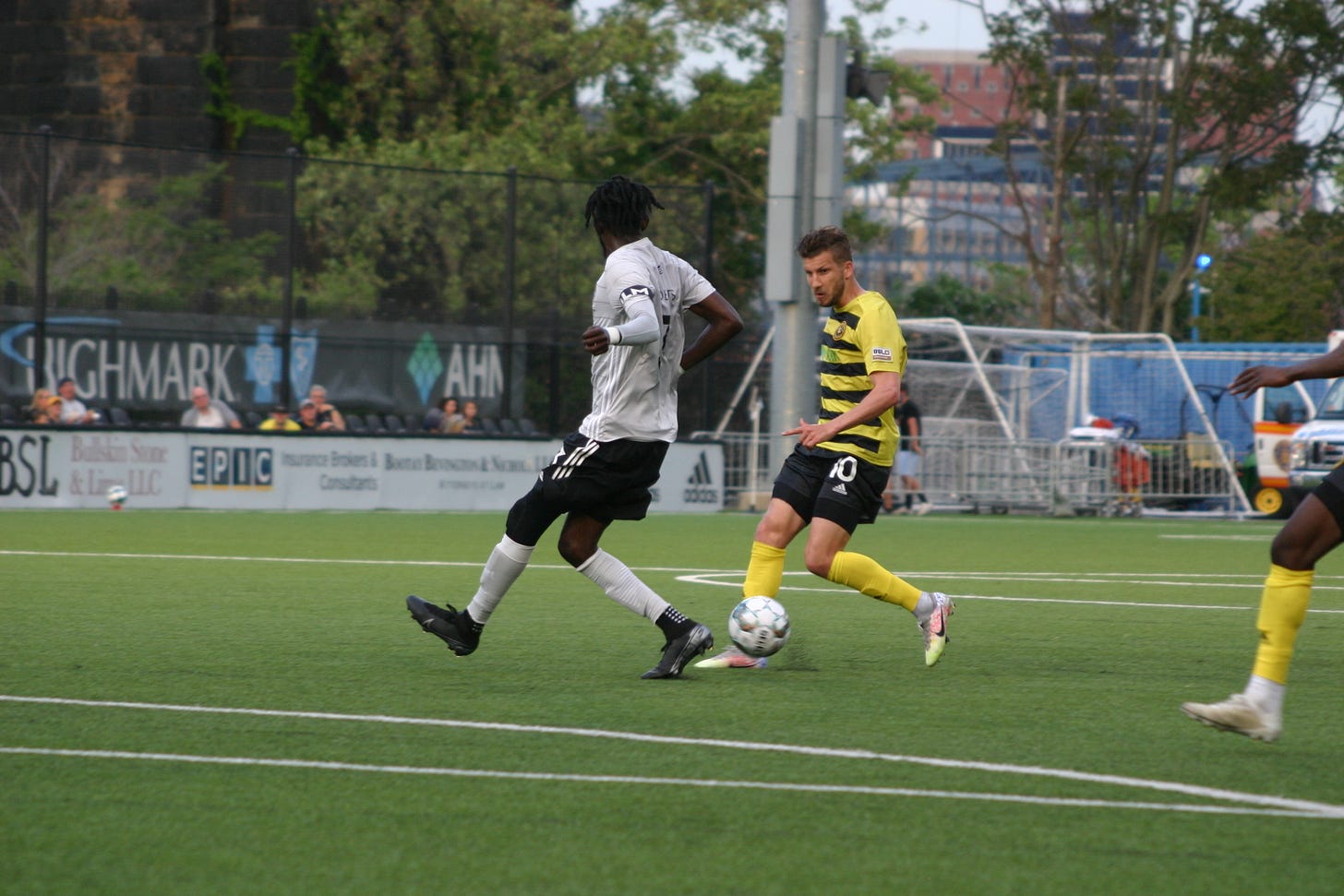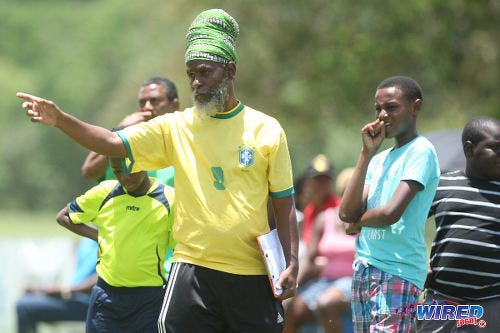Backpass: From 'Pirate' to Pro
The path to stardom begins at the local park or in the backyard. An interview with four top pro players: Sam Vines, Mekeil Williams, Russell Ciccerone, and Oliver Larraz.
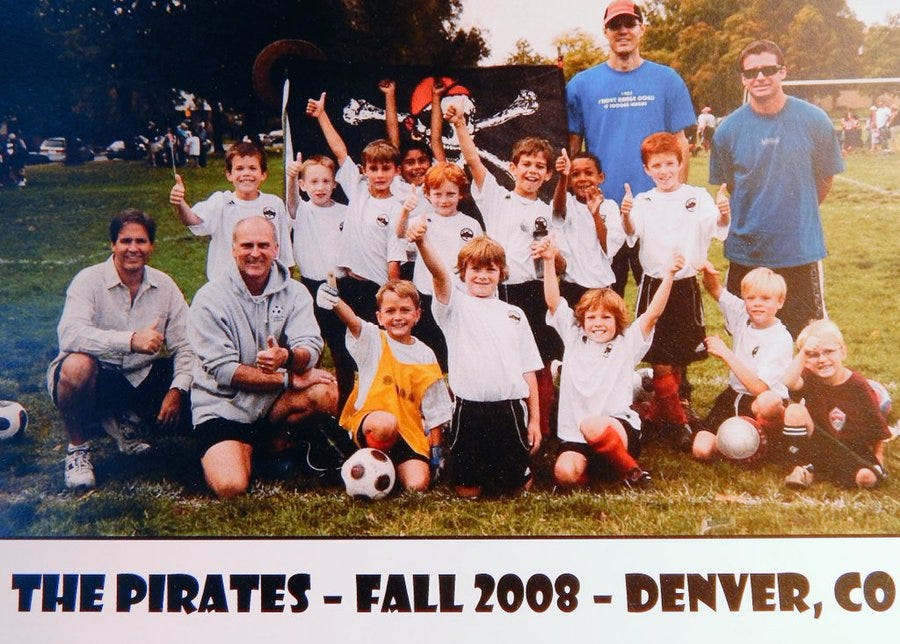
There you are: on the back porch of your house; or in the hatchback compartment of the family SUV in the parking lot; or in the entryway to the apartment you grew up in. Splayed across the floor with a pair of hand-me-down cleats. Or perhaps a brand new set of boots from the sporting goods store - fresh out of the box with that scent of outgassing plastic mixing neatly with the electric neon colors of the laces and the graphics. And in the bag with them - a set of shinguards. Something alien and strange, but it makes you feel like a warrior, or maybe a grownup even. You are six, or maybe seven.
You don’t yet know how to tie your shoes. You don’t know how to put on the shinguards - and maybe your parent doesn’t, either. The two of you fumble and shove and strap and stretch and pinch and push. And finally, with the gear all assembled, you stand up. The cleats click brightly on the tile floor as if Gregory Hines was tap dancing across the room. That echoing ‘click’ reminds you of the sound you hear on television on Saturday morning as Liverpool or Chelsea click-clack, click-clack their way down the tunnel to the great green expanse of the field.
You are transformed. You are a footballer. Or at least, you are your way to being one, anyhow.
…
I know this isn’t really news to most of you, and yet it still needs to be said: not every player that joins a U6 recreational team at the local community center will grow up to be the next Lionel Messi. The goal of youth soccer is to let kids have fun, to create community, and to get a little exercise. And yet the path to becoming a great footballer absolutely begins at a young age. Every professional soccer player discovered the sport, loved it, and committed to it. There were critical experiences that help develop them. There were critical people, too, and critical local clubs that incubated their nascent talents.
This is the story of four players, and their path from the ‘Orange Crush’, the ‘Pirates’, the ‘Blue Waves’ or the ‘Sandwich Dragons’ to becoming professional soccer players.
…
The Ones with the Ankle Band
Mekeil Williams started his soccer career the way everybody does: kicking around the ball with a parent in the yard.
Williams tells me, “From the first time I could remember I just always loved soccer. So I would always be kicking around the ball back home in my yard, I would go play soccer with my dad and his friends until I first joined the time.”
Williams is 30 years old now - something of a grizzled soccer veteran. The versatile defender can play any position along the backline comfortably. In his remarkable career, he’s played for clubs in five different countries - the US, Poland, Guatemala, Denmark, and his native Trinidad and Tobago. He has 28 caps (appearances) for the T and T national team, and he played in MLS for the Colorado Rapids in 2016 and 2017. He currently plays center back for the Pittsburgh Riverhounds in USL.
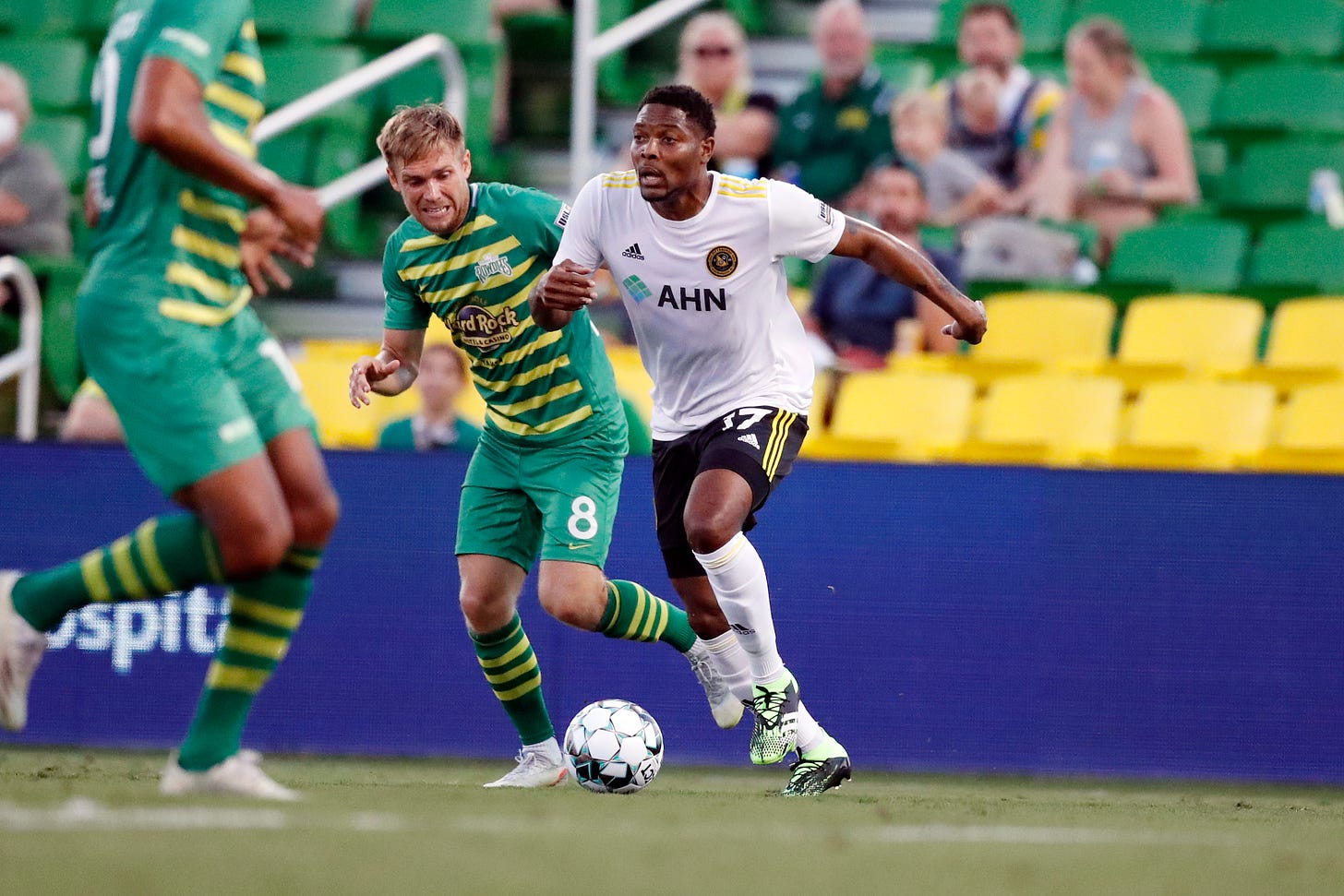
He remembers those early days with his first set of gear, getting dressed with a parent’s help before a first game in his hometown of Belmont, Port of Spain, Trinidad.
“I remember when my dad brought the shin guards to me. That was the ones with the ankle bands attached to it. So he had to show me how to put it on.”
“Oh I don’t still have them but I remember them. They were Mitre.”
US Men’s National Team left back Sam Vines has that same memory, a dozen countries away and a decade later. Vines told me “I remember my parents would always get the cleats out, with the shin guards. The shin guards had that little ankle pad and all that, and they’d put that on for you. They’d do everything for me. Then they’d get you in the car. Get your seatbelt on, and have the snacks at halftime.”
Vines started out his career with a local club in his hometown of Colorado Springs, Colorado called ‘Strikers’. “I started in a rec club. I was probably five. Man, that was a long time ago.” Consider that Vines is only 22 years old, meaning he would have joined this team in 2004 or 2005. For many of us oldsters, we are now recognizing the concept of ‘long time ago’ as highly relative.
“My parents put me in a club called Strikers, they wanted to see how I did. I liked it, I had fun all the time.”
When he was around eleven years old, he switched clubs, but not for any hyper-competitive ‘this is the way to go pro’ reason. He just wanted to make friends. “My other friend asked me if I wanted to play for their other club team, and I was like ‘Yeah ok I’ll try it.’ I ended up thriving in it - that club is called Pride SC. I made a lot of good friends over there too.”
Vines eventually would move in his later years from Pride to the Colorado Rapids Academy, and from the Academy to the senior team. He got his first international cap for the USMNT in February, 2020.
You would think that a player of Vines caliber - one of the most promising left backs in all of the US and a young man that made MLS’ coveted ‘22 under 22’ list last year - would have always been brimming with confidence. Not so.
“I remember the first time I joined Strikers - I was nervous, joining a new team, new guys. But at the end of the first day, I was really happy that I joined the team, they really made me feel welcome.” Having a core of friends on the team - a comfortable atmosphere that allows everyone to shine, was ultimately critical to Vines’ success, as it was for many of the players I interview.
…
Now’s a good time to click ‘subscribe’ - to get this amazing newsletter of free content on your Colorado Rapids, delivered straight to your inbox. Or perhaps you even want to help support all the HTHL media endeavors by becoming a full-fledged ‘Highliner’ - a subscription-level package that gets you one bonus column per month, plus discounts on upcoming swag. It also is a great way to tell Matt and I ‘I love what you do - keep doing it!’
…
‘I Love Watermelon’
Oliver Larraz is, once again, a teammate of Vines on the Colorado Rapids Senior team, after the slow progression through the Rapids youth academy. Larraz is the most homegrown of homegrown stories - he’s only played for one club, his whole life - the Colorado Rapids. Larraz, a mop-topped redhead, is uniformly referred to by his fellow pros in the Rapids locker room by the nickname ‘Scholesy’ due to his similarities to England’s legendary ginger-haired midfielder, Paul Scholes.1
He began as a little tyke with the Colorado Rapids Youth Soccer Club (CRYSC), a recreational soccer team that plays throughout Denver and nearby cities in Colorado in parks with trees just past the outfield and dandelions on the pitch and fields that occasionally slope or dip in spots because they’re, well, parks, not fancy soccer pitches. Often playing up several division - he was an 11 year-old on the U13s, a 13 year old on the U16s, etc. - Larraz played with Sam Vines on several academy teams for Colorado before Vines signed a professional contract. Oliver would eventually put his signature on a pro deal too; three years after Sam.
Larraz grew up in the Park Hill neighborhood “just east of the Zoo” and after graduating from bumpy city parks, spent loads of time on some of the better soccer pitches familiar to Denver natives: Aurora Sports Park and Dick’s Sporting Goods Park.
His early gear memories weren’t about the brand of his shin guard, but rather a ritual that he start at an early age and still maintains to this day.
When he was young he “started with a little superstition of putting my left cleat on first as opposed to the right. I dunno why.”
Superstition, habituation, and tradition are a big part of all sports, including soccer. You do a thing, the thing works, you like the thing, you succeed. You associate the thing with winning. So you keep doing the thing. Or maybe you just like the thing, win, lose or draw. Larraz’ thing, other than ‘left cleat first’, became ‘Aurora gas station breakfast burritos’.
“When we went to Aurora Sports Park there was a little gas station owned by a Mexican family, and they would have breakfast burritos, so after games we’d stop there and get ‘em. They were delicious.”
Sam Vines also has a key food: watermelon.
He says, “I love watermelon. And after the game, my mom would have watermelon for me. That’s probably the snack that I would always want after games.”
That Thing You Do
Rhythm and habituation are valuable in terms of comfort and mental preparedness, but one of the most important aspects of progressing from a great youth player to a great pro is perfecting foot skills. All four of the players I spoke to had a thing they did, over and over and over again, on their own before or after training, at home.
Often, the thing they loved to practice the most has become their signature skill in football - their forte.
Russell Cicerone wears the number ‘10’ for the Pittsburgh Riverhounds, often denoting an attacking midfielder with devastating close-touch dribbling ability. But Cicerone plays most often as a striker - and that’s an inclination he was hard wired to as a kid. The now 26-year-old Cicerone says “We had a pretty big backyard, so I had a full size net back there. My dad would hop in goal and me and my sister would just rip shots at him from 20, 25 yards out, seeing who would get the most power.”
That practice clearly paid off: the Bloomfield Hills, Michigan native was a standout high school player for both his club team, Vardar, and his school, Brother Rice. Cicerone helped guide his high school to the High School Division 2 Michigan State Championship in 2012. He played collegiate soccer for the University of Buffalo and was drafted by MLS’ Portland Timbers. He’s been a successful USL striker with several teams, and is now a Pittsburgh Riverhound.
For Cicerone, the regular sports rituals weren’t just for soccer - he was a two sport athlete, playing both soccer and hockey - so the ‘getting your gear on, driving to practice’ routine with his parents was a bit more frenetic. Sometimes, it was driving straight from school to soccer to hockey, or the reverse.2
Cicerone says “I’m from a sports family. I pretty much did everything, like a lot of American kids when you’re young. But when you grow up, you find out what you’re good at. Competitively, in high school, I played hockey and soccer. Both my parents were very supportive of all the sports I played. Whatever the problem - if my cleats were giving me blisters they were there taping me up.”
“I’d be coming from baseball practice and on the way, my mom would be taping me up in the back of the van while my dad was driving me.”
The signature skill for Sam Vines is his ‘cultured left foot.’ Rapids Director of Development Brian Crookham told me in 2018 that Vines was “one of the best passers in the entire Rapids system” and that he was “deadly on free kicks.” That was three months *before* he signed a professional contract. He developed that skill not at practice, but on his own.

Vines tells me, “I would honestly take free kicks for … hours. Literally, the whole afternoon I would just take free kicks.”
But another critical skill for left backs is settling long kicks or hard-hit balls with the softness and subtlety of a hand going into a glove. That often overlooked skill, also, involved hours and hours of practice.
For Vines, that practice paid off, but it did also irritate his mother to no end.
“The other thing was, I know my mom got really mad at me for doing it, but I kept hitting the ball against the side of their house, working on my first touch. So I’d just punt it against the house, let it come down to me. And it rattled the house: she’d come yell at me, and I’d stop for five minutes, and then do it again.
Clearly, though, Vines truly enjoyed - and still enjoys - striking the ball and receiving the ball cleanly, time and time again.
“Yeah, that’s definitely a good memory.”
Mekeil Williams is certainly skilled with passing and receiving, but the signature skill he developed at a young age was his dribbling.
In his sing-song Trinidadian accent he says “So back home in the yard there was two houses in one yard, and I had a hockey sized goal, so I would be runnin’ all around, between the trees, dribblin’, doing all types of tricks, scorin’ goals, just runnin’ around everything.”
But despite being a defender and making a career advancing the ball to midfield so that somebody else can lead the attack, Mekeil has always enjoyed goal scoring most of all. One of his most vivid youth memories was his first goal, which he scored when he was nine.
“The first time scoring a goal is a feeling. It was a free kick, actually it was pretty far. To be honest, I don’t even think I was trying to take a shot, I was just trying to play it forward a ball into the box. And just at that moment, I loved it. Scoring goals, I love scoring goals. Even when I’m a defender, sometimes I wish I could just score a goal.”
Although they call Oliver Larraz ‘Scholesy’, the player he watched and tried to imitate in his backyard from a young age was actually Andrés Iniesta, Barcelona’s flawless midfield manager and distributor, and one of the best to ever play the game.
Larraz says, “I watched Iniesta a lot growing up. And so every single day, before training, I would spend 15 minutes in my backyard with just a ball. And there was a video on youtube, it was basically ‘change direction’. It was basically 30 seconds of the exact same change of direction, over and over and over. So, like, traditional drag back, Cruyff turn, ‘L’ drag-back. All those seem to be basic. But, I think a change of direction - people forget that that’s the technique and a skill. If you can look one way on the field and then change direction and go the other way, it’s super helpful. I did that, everyday, for years, before training.”
…
The Legendary Coaches of Global U10
It is clearly not enough to bang a ball off the family home or practice youtube skills all day, everyday. The creation of a good youth player that will carry their raw ability and desire forward requires talented teachers and coaches at the club level. And all four of the players I spoke with remember one particularly influential coach that helped mold them on their path to being a pro.
Mekeil Williams credits a nearly mystical figure in T&T soccer known as ‘Dada’ with both identifying him and helping set him on the right course.
“The coach from Trendsetter Hawks, everyone knows him as Dada (Anthony ‘Dada’ Wickham), that’s one of the guys that groomed a lot of the top players for the national team. I don’t actually know his name. That name’s so well known. Everybody in Trinidad knows Dada.”
Williams started with another club, St Francois Nationals, as a young player, but as he grew into a youth international and then a pro player, he joined Dada’s Trendsetter Hawks, a feeder club for many Trinidad and Tobago youth internationals.4
Russell Cicerone had a similar influence; his youth coach was so important that Cicerone still retains him for training to this day. “A coach that had a huge impression on me was Aaron Byrd. He was my coach from U7 to U9. Very technical guy, young guy, very motivated at the time. And now he runs one of the biggest individual training programs in Michigan. Every offseason I go off with him and train.”
Larraz’ guiding star was a U11 coach. “Robbie McLaughlin. Really focused on my technical skill and the technical proficiency. We would spend weeks - months - with just how to receive the ball. The way to play it with the outside of your foot as opposed to the inside of your foot.”
Vines, for good measure, points to three coaches. Two of them are ‘volunteer weekend mom/dad’ variety of coaches that maybe played in high school and took a couple of United Soccer Coaches online courses. These passionate volunteers are often the backbone of American soccer. They coach not because it pays, but because it’s important. Because they love it.
Sam explains,“Brian Contreras, he’s kinda big in Pride. He was my coach for three years. And when I joined the Strikers, there was two dads that were coaching - Tom McClain, and Craig Domann. I learned a lot from them.”
Soccer for all, regardless of race, religion, or economic situation
Some of the clubs mentioned have resources behind them, like Vardar and CRYSC. Others, perhaps less so. One of the well-documented challenges of youth soccer in the US is an imbalance of opportunity. There are community clubs that charge little - sometimes nothing - to play. And then there are ‘elite’ ‘academy’ or ‘travel’ clubs, where all the coaches are paid and the cost of soccer can run from thousands to *tens* of thousands of dollars annually for each player. That can be a challenge for a family with the desire, but not the resources. It then falls to club administrators or coaches work things out, if they can.5
For Sam Vines, this situation was not theoretical: it was personal and real.
“Credit to all the coaches and people that helped push me forward to do what I wanted to do, especially Pride. You have to pay to play there, and fortunately for me, my teammates were able to pay a little extra to let me play there, because we weren’t in the best financial place at the time.”
The fact that high-end soccer is too expensive for some could have ultimately ended Sam Vines soccer journey. But thankfully, some smart folks saw a kid that loved the game, and ensured that the game loved him back, regardless of whether his family could pay the fees.6
“Pride worked it out with us so that we didn’t have to pay, and I’m thankful for them.”
Shout out to the Mums and Dads
For these four players, the last critical element - beyond fanatical desire to skill development, beyond love of the game, beyond the guidance of a wise coach - was the commitment of parents to supporting their sons. With long drives and snacks and volunteer coaching and a million other things.
Cicerone tells me “Growing up, my family was very supportive, very driven to get me to a high level, and I can’t thank them enough.”
Larraz had a soccer-loving, competitive dad help push him along. “My dad is big into soccer. He coached me, pretty much throughout my youth. He helped me train in the mornings.”
Vines had two older sisters and five younger brothers, and his parents drove all of them to sports - gymnastics for the girls, soccer for the boys. Sam’s brothers - ages 17, 15, 14, 13, and 11, are all in the Rapids system. Two are with the top Academy teams Jeremiah Vines with the U14s and Kohen Vines with the U13. That’s a lot of driving. And a lot of watermelon.
Believe in yourself
Of course, at the end of the day, the ultimate determiner of a player’s ceiling is themselves and their desire. Soccer at the highest levels is tough, it takes equal parts skill, determination, and desire to keep progressing when other youths have decided to do other things or decide they don’t think they have what it takes. Oliver Larraz, the youngest of our players, explains this with a degree of wisdom that seems to far exceed his life experience of someone the tender age of 19.
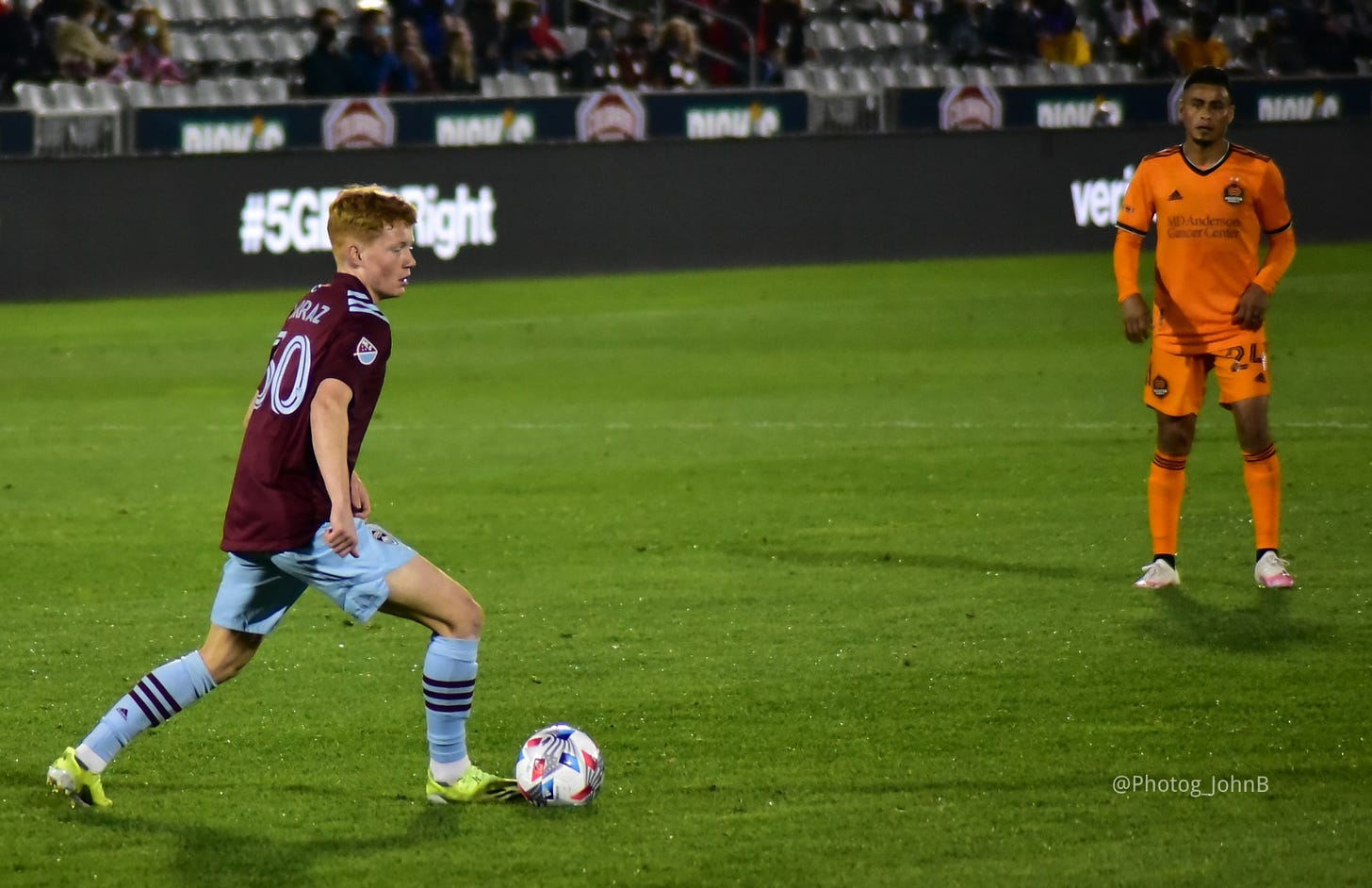
“The number one thing is self-belief that it can happen. It’s between being, like, cocky - saying ‘I’m gonna make it for sure’ - and just self-belief that ‘I’m good enough to make it.’
“I just need to work hard, but I’m good enough to make it.’”
Larraz was given the moniker by USMNT Goalkeeper and Rapids Designated Player Tim Howard, who played for Everton Football Club from 2006 to 2016. Over that time, Everton played Scholes’ Manchester United team 23 times. So, that’s pretty cool.
I am just exhausted thinking about this. These days I sometimes take a nap after driving to pick up my kids. Just driving. And it’s not even far.
I tried really hard, but I don’t think I found the exact right video. This is at least ‘a good sense of’ the kind of skills little Ollie Larraz practiced over and over and over again.
Look at this guy. Just based on this picture, I want nothing more than to sit at this man’s feet and drink in his wisdom. Source: Wired868.com.
Additionally, we know that soccer is socially or economically promoted in some regions or ethnic groups differently that others, and that park space and access to facilities and coaches is not equal across different neighborhoods. This article is not really about that. But it’s not *not* about that either.
When I imagine a world in which a talented soccer player can’t afford the club fees and drops out - when I imagine a world that might have been deprived of the beautiful sight of Sam Vines bending in a cross from the wing - I literally find myself on the verge of tears. Yes, I also cry watching rom-coms on airplanes.




